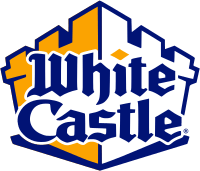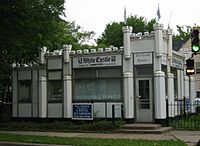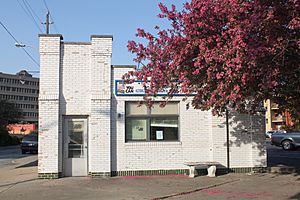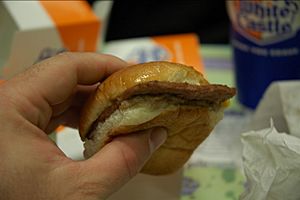White Castle (restaurant) facts for kids
 |
|

White Castle Building No. 8, originally built in 1936 in Minneapolis, Minnesota, and later remodeled. The castle-like features mimic Chicago's Water Tower Pumping Station. White Castle no longer operates this building, which is currently an antique shop.
|
|
| Private | |
| Industry | |
| Founded | March 11, 1921 Wichita, Kansas, U.S. |
| Founders |
|
| Headquarters |
,
U.S.
|
|
Number of locations
|
377 |
|
Areas served
|
|
|
Key people
|
Lisa Ingram (CEO) |
White Castle is an American regional hamburger restaurant chain with 377 locations across 13 states, with its greatest presence in the Midwest and New York metropolitan area. It has been generally credited as the world's first fast-food hamburger chain, founded in 1921 . It is known for its small, square hamburgers referred to as "sliders". The burgers were initially priced at five cents until 1929 and remained at 10 cents until 1949. In the 1940s, White Castle periodically ran promotional ads in local newspapers which contained coupons offering five burgers for ten cents, takeout only.
Despite being founded in Wichita, Kansas, the restaurant has not operated a location in the city since 1938.
On January 14, 2014, Time labeled the White Castle slider as the most influential burger of all time.
Contents
- History
- Background
- Founding and early activity
- 1925: White Castle Official House Organ, success, expansion and imitators
- 1932: Paperlynen subsidiary
- 1934: Porcelain Steel Buildings subsidiary
- Buyout of Anderson, headquarters relocation, and expansion
- Cravers' Hall of Fame
- Location expansion and vegetable sliders
- Activities
- Products and marketing
- Impact
- See also
History
Background
Walter (Walt) A. Anderson (1880–1963), a cook, had been running food stands in Wichita since 1916 when he opened his first diner in a converted streetcar. After a second and third location, he was looking to open a fourth location when he met Edgar Waldo "Billy" A. Ingram, an insurance and real-estate man, and together they started the White Castle chain.
Founding and early activity
White Castle was founded in March 1921 in Wichita, Kansas. Anderson partnered with Ingram to make White Castle into a chain of restaurants and market the brand and its distinctive product.
Anderson and Ingram started with only $700 for the original White Castle in Wichita, Kansas. The original location was the northwest corner of First and Main; the building is no longer standing.
At the time, Americans were hesitant to eat ground beef after Upton Sinclair's 1906 novel The Jungle had publicized the poor sanitation practices of the meat packing industry. The founders set out to change the public's perception of the cleanliness of the industry they were creating. To invoke a feeling of cleanliness, their restaurants were small buildings with stainless steel interiors, and employees outfitted with spotless uniforms. Their first restaurants in Wichita, Kansas, were a success, and the company branched out into other Midwestern markets, starting in 1922 with El Dorado, Kansas.
1925: White Castle Official House Organ, success, expansion and imitators
The company also began publishing its own internal employee magazine, the White Castle Official House Organ, circa November 1925 (it was originally named The Hot Hamburger). The bulk of the material was contributed by company personnel and consisted mostly of letters and photographs of workers, promotional announcements, 25-year milestones, retirements, and similar items of interest arranged by geographic area. "Employees could... read about the progress and innovations made by those in other areas which made everyone aware of the entire system's direction and condition." The White Castle Official House Organ was published quarterly at least through the early 1980s, and at some point was renamed The Slider Times. The Ohio Historical Society houses an extensive archive of White Castle System, Inc. records from 1921 to 1991, including issues dating from 1927 to 1970 of the White Castle Official House Organ.
The earliest buildings, such as Indianapolis White Castle #3, built in 1927, had exteriors of white enamel-glazed brick and interiors of enameled steel. The Indianapolis unit was in operation until 1979, making it, at the time of its closure, the longest-operating fast food restaurant in the country. The company constructed this style of building from 1924 to 1929. White Castle Building No. 8, in Minneapolis, Minnesota, originally built in 1936 and remodeled (photo in infobox above), is an example of the chain's buildings with prefabricated white porcelain enamel on steel exteriors. The building measured 28 feet (8.5 m) by 28 feet (8.5 m) and was made to resemble the Chicago Water Tower, with octagonal buttresses, crenelated towers, and a parapet wall.
The success of White Castle led to numerous imitators. Restaurants copied the distinctive architecture of White Castle buildings, as well as created confusion for consumers by using a similar name. The first of these imitators in Wichita was Little Kastle. Many competitors created their names with a play on the White Castle name. Some restaurant chains just replaced the word "Castle" with their own word (Cabin, Cap, Clock, Crescent, Diamond, Dome, Fortress, Grille, House, Hut, Kitchen, Knight, Log, Manna, Mill, Palace, Plaza, Shop, Spot, Tavern, Tower, Turret, Wonder), while others chose to replace "White" with another color or adjective (Blue, King's, Little, Magic, Modern, Prince's, Red, Royal, Silver). Some of the other imitators included Castle Blanca, Blue Beacon, Blue Bell, Blue Tower, Red Barn, Red Lantern, and Klover Kastle. Despite all the competition, none of the competitors was able to match the success of White Castle.
1932: Paperlynen subsidiary
Since fast food was unknown in the United States at the time of White Castle's founding, there was no infrastructure to support the business, as is common with today's fast-food restaurants. The company established centralized bakeries, meat supply plants, and warehouses to supply itself. It was said that the only things that they did not do themselves were raise the cows and grow their own wheat. Ingram developed a device to produce previously unheard of paper hats (for employees to wear as part of the uniform).
In 1932, Ingram set up a subsidiary, Paperlynen, to produce these hats and other paper products used in his restaurants as well as for many other purposes. At the time, White Castle's distribution stretched from Wichita to New York. Ingram decided the central office should be in the center of the distribution area. (To accommodate this, in 1936, the central office would relocate to Columbus, Ohio. Furthermore, in the same year, Ingram decided to close all of the restaurants in the two smallest-profit markets, Wichita and Omaha.)
In 1955, Paperlynen produced over 42 million paper hats worldwide with more than 25,000 different inscriptions.
1934: Porcelain Steel Buildings subsidiary
White Castle also created a subsidiary in 1934 named Porcelain Steel Buildings that manufactured movable, prefabricated, steel frame structures with porcelain enamel interior and exterior panels that could be assembled at any of its restaurant sites. This is the first known use of this material in a building design.
Buyout of Anderson, headquarters relocation, and expansion
In 1933, Anderson sold his half of the business to Ingram, and the following year the company moved its corporate headquarters to Columbus, Ohio. Co-founder Billy Ingram was followed as head of the firm by his son E. W. Ingram Jr. and grandson E. W. Ingram III.
In 1959, White Castle expanded into new markets for the first time since the 1920s. Billy Ingram, who had retired to Miami in 1958, built three White Castle restaurants there. The company closed the Florida operations in 1967 due to inefficient supply distribution.
Throughout its existence, White Castle has been a private company and relied on company-owned stores. It remains privately held today, and its restaurants are all company-owned; none is franchised, except very briefly in Japan during the 1980s and more recently in China since 2017.
Cravers' Hall of Fame
In concurrence with its 80th anniversary in 2001, White Castle started its Cravers' Hall of Fame. "Cravers" are inducted annually based on stories written about them by another person or that the particular Craver submits for consideration. Between five and 10 stories have been chosen each year, with a grand total of 64 stories selected through the 2007 induction class. This represents less than 1% of the total stories submitted since the inception of the Cravers' Hall of Fame, an indication of the exclusivity of the honor.
Inductees are invited to attend the White Castle Leadership Conference in the chain's hometown of Columbus, Ohio, with full travel, dining and hotel accommodation expenses covered. Furthermore, each inductee receives a celebratory plaque in front of hundreds of White Castle leadership and operations team members.
Location expansion and vegetable sliders
The first White Castle in the far western United States opened at the Casino Royale Hotel & Casino on the Las Vegas Strip on January 27, 2015. This was the first expansion for White Castle into a region outside the Midwest and Northeast in 56 years. On the first day of business, demand for food was so great that the restaurant had to temporarily close for two hours to restock. White Castle Vice President Jamie Richardson said that the store sold 4,000 sliders per hour in its first 12 hours. He was not aware of any similar closing due to unexepected demand in White Castle's 94-year history. A second White Castle location opened in Las Vegas on September 22, 2017, on Fremont Street, and a third opened in Jean not long after.
In September 2015, White Castle began to offer Veggie Sliders with dairy-free buns to provide a vegan option.
In December 2015, White Castle announced that chief executive officer (CEO) E.W. “Bill” Ingram III would step down at the end of the year, but continue to be chairman of the board. His daughter, Lisa Ingram, then became the fourth CEO of the company.
In 2018, White Castle began offering meat-free Impossible Burgers designed to closely mimic the flavor and texture of beef burgers.
The first White Castle location in Arizona opened in Scottsdale on October 23, 2019.
White Castle announced on November 25, 2019, that the chain would return to Florida after previously leaving the state in 1968, with plans to open the first restaurant in Orlando. A ghost kitchen, operated out of the restaurant while it was under construction, overloaded Uber Eats when it opened for one day on February 24, 2021. The Orlando location opened on May 3, 2021. It is the world's largest White Castle, located on Daryl Carter Parkway off Interstate 4. The opening coincided with White Castle's 100th anniversary.
Activities
United States
The Ingram family's steadfast refusal to franchise or take on debt throughout the company's existence has kept the chain relatively small, with a more discontinuous geography than its principal competitors. There are 377 White Castle outlets, predominantly in the Midwest, Kentucky, and Tennessee. The exceptions are about 50 in the New York - New Jersey metropolitan area, three locations around Las Vegas, Nevada, one in Scottsdale, Arizona, one in Orlando, Florida, and two in Shanghai, China. By comparison, there are over 36,000 McDonald's locations globally, with approximately 14,000 of those in the United States. The chain does, however, sell frozen sliders at supermarkets nationwide, with availability varying by chain.
Current White Castle markets in the United States:
- Chicago (includes Kenosha, Wisconsin)
- Cincinnati
- Columbus
- Dayton
- Detroit
- Indianapolis
- Las Vegas
- Lexington
- Louisville
- Minneapolis–St. Paul
- Nashville
- New York - New Jersey (includes Allentown, Pennsylvania)
- Orlando
- Scottsdale, Arizona
- St. Louis
Louisville and Columbus also house bulk-manufacturing (grocery-store sales, meat, and bun production) divisions. Company headquarters and the Porcelain Steel Buildings division are in Columbus, Ohio.
In the early 2000s, White Castle tried expanding into three new cities, Philadelphia, Kansas City, and Cleveland-Akron. Those restaurants closed within several years. White Castle exited Cleveland-Akron effective December 25, 2014.
International activities
Through franchise deals with local corporate business partners, White Castle briefly had restaurants outside of the United States in Singapore, Malaysia, and Japan during the late 1980s and early 1990s, but the concept never caught on in those countries. During the same time period, White Castle also tried to establish franchised operations in Mexico and South Korea, but these restaurants also failed. The lone Korean restaurant in Seoul was quietly closed by 1993.
In 1986, White Castle opened its first Japanese restaurant in the city of Osaka via a franchise deal with a Japanese company. There are no reliable records that show when this location closed and when the company finally left the Japanese marketplace. By the end of 1986, the Japanese franchise had six restaurants with a seventh opened by the following year.
In June 1989, White Castle and its local franchise partner Innovest Bhd. opened seven restaurants in Malaysia. Innovest franchise territory included Malaysia and Singapore, and the company had plans to open three more restaurants by the end of the year, with the possibility of having a total of 20 restaurants within its two country region by the following year. There is no evidence if the company did or did not achieve their goals, and there are no reliable sources that describe the fate of these restaurants and when all of these restaurants had finally closed.
The first White Castle franchised location in Mexico opened in Mexico City in 1996, but it also closed after a brief trial run.
In 2017, White Castle opened its first and second restaurants in China in the city of Shanghai through a partnership with Shanghai-based ClearVue Partners. In addition to beef sliders, the Shanghai location also sells a spicy tofu slider and a cherry duck slider, which is smoked duck topped with a sweet cherry sauce. At the time of their openings, these two restaurants were the only White Castle restaurants located outside of the United States.
Although White Castle has never opened any restaurants in Canada, Canadians have been able to purchase White Castle hamburgers from the frozen foods section in select Canadian grocery and convenience stores since 2015 and more recently at Walmart.
- Countries formerly with White Castle
Products and marketing
White Castle also markets its sandwiches in 30-hamburger boxes, called a Crave Case. The figure of 30 burgers represents the number that can be produced on one of its standard grills at the same time. A "Crave Crate" is also offered, with the contents being 100 burgers.
A variety of White Castle products (mostly frozen) are also sold in grocery stores.
Some locations had been cobranded with Church's Chicken. Church's is a national fried chicken chain of restaurants. That co-branding arrangement ended around 2010.
Around 2012, White Castle experimented with the Laughing Noodle brand that was to share space with White Castle restaurants. The Laughing Noodle concept was discarded a few years later. The Laughing Noodle brand was developed to offer supplemental variety to a White Castle Restaurant. At least one such location was constructed and operated in Sharonville, Ohio.
Although White Castle originated in Wichita, Kansas, the city has not had a restaurant since 1938, nor is there a White Castle restaurant in the entire state of Kansas. White Castle is one of the few restaurant chains that does not have a location in its original city. In the early 2000s, White Castle tried expanding into the Kansas City market, with at least one location in Kansas, but those restaurants were closed several years later.
In April 2020, White Castle respond to the COVID-19 pandemic by announcing that the chain would be delivering free meals to healthcare workers. White Castle also offered a free dessert in the month of May 2021 to anyone who showed a vaccination certificate.
Impact
Anderson is credited with the invention of the hamburger bun as well as "the kitchen as assembly line, and the cook as infinitely replaceable technician," hence giving rise to the modern fast-food phenomenon. Due to White Castle's innovation of having chain-wide standardized methods, customers could be sure that they would receive the same product and service in every White Castle restaurant.
Ingram's business savvy not only was responsible for White Castle's success but for the popularization of the hamburger. On January 14, 2014, Time labeled the White Castle slider as the most influential burger of all time.
See also
 In Spanish: White Castle (restaurante) para niños
In Spanish: White Castle (restaurante) para niños



